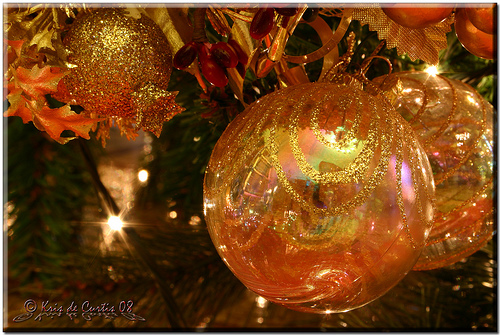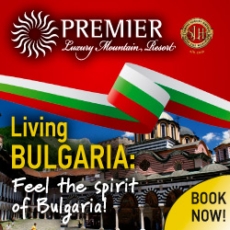Vanya Nikolaeva
Christmas – beginning of Anno Domini, symbol of faith and love, and the most expected holiday among people of Christian faith.

Photo: krisdecurtis
How do people celebrate Christmas around the world? What does the holiday have in common in all different cultures and how does it differ? The wreath, symbol of continuousness, and the Christmas tree, embodying life, have their silent but compelling presence in almost every home during the holiday season.
If you are in Asia taking a walk in Seoul, no matter if near the Cheonggyecheon river (with sumptuous decorations on the two watersides) or the wide central streets, the Christmas spirit is captivating. Exchanging gifts and holiday cards with Christmas themes is common, and if you hear a name repeated – Santa Haraboji – you could guess that is how the generous traveler with white beard is called. South Korea is the only Asian country where Christmas has a national prominence.

Photo: karinc
South Korea
The Christmas tradition was brought to China and Japan by the Christian missionaries and today it is a religious holiday in China, while Japanese people recognize New Year’s Eve as the family holiday; Christmas has a more social meaning and it is usually spent with friends in a restaurant or club.

Photo: rumpleteaser
Japan
The longest holiday season is celebrated in the Philippines, traditionally ushered in by the nine-day dawn Masses starting on December 16th, known as the Misas de Aguinaldo. Christmas Eve is the much-anticipated traditional Christmas feast (noche buena) after the midnight mass. The climate notwithstanding, the Christmas tree and decorations, as well as Santa images, have their invariable presence.

Photo: meanestindian
India
Christians in India barely reach 3% of the population and the holiday is known in this country as bada din (The big Day) and “Christmas vacation”, starting a bit before Christmas Eve and ending a few days after New Year’s Eve. Indians became acquainted with Santa Claus in the mid-90’s, but the idea of sledge and reindeer is not popular – by reason of the high temperatures in the country, where snow exists only in one’s imagination.
Christmas is the most anticipated holiday in Congo and in Nigeria, where it is celebrated mainly in the Southern and Eastern parts of the country. Nigerians prepare a traditional dish (pounded yam) and have it for their luncheon/dinner a few times that day, since it is the custom to visit relatives and close friends and of course, the exact same menu is “on the list”.
Christmas Eve is the most significant holiday in Brazil. Gifts, Christmas trees and traditional dinner are parts of the atmosphere in Brazilian homes, all dressed up in lights decorations. There is no Christmas without a tree and gifts exchange in Guatemala , and carol-singers in Mexico recreate in the course of 9 days the travails of Jesus’ parents, begging for shelter right before his birth.

Photo: santarosa
Brazil

Photo: grassvalleylarry
Mexico
Australians celebrate Christmas with some blue ocean spirit and a Christmas luncheon, while Santa Claus is depicted with an “akubra” hat, summer outfit and sledge, pulled by kangaroos. Gifts are placed in textile bags usually hung above the fireplace, as the tradition continues on even in the absence of a burning fire.
People in New Zealand sing carols in the parks and arrange “Christmas barbeque”; the pine tree is replaced by the Pohutukawa tree, named “New Zealand Christmas tree” – always in blossom in late December. A sky of thousands of lights is seen on windows, fences and roofs.

Photo: mattsheppard
Australia

Photo: the-lees
Pōhutukawa tree, New Zealand
Christmas is a special holiday in the USA and on the Saturday after Thanksgiving day, Santa Claus announces the start of the holiday season. Kids hang socks over the fireplace, which are full with sweets and small toys in the Christmas morning.
In many Canadian homes people prepare a Christmas tree, a mantle and a manger. When the midnight mass is over, they spend the night with their families.

Photo: preciouskhyatt
Canada
In Ireland, Christmas has a special religious importance and is the longest celebrated holiday in the country – from 24th of December till 6th of January.

Photo: topgold
Ireland
Georgia celebrates its Christmas on 7th of January; holiday masses and festive processions are a part of the tradition. Kids participate by giving away sweets to the elders they meet. Georgian Santa Claus has the name of Tovlis Papa.
Armenian Christmas comes on January 6th. The Christmas tree, called tonatsar, can either be genuine or artificial. Santa Claus is always attending under the name of Dzmer papik.
The Ukrainian people have their “Holy supper” and the table is usually decorated with an embroidered tablecloth with themes picturing the Bethlehem manger and a head of wheat in a vase. Carols are sung and while everyone is having dinner – “angels” leave presents under the Christmas tree.

Photo: krisdecurtis
Hungarians decorate their Christmas trees and wrap presents up on 24th, but Santa has nothing to do with that holiday. He (St. Nicolas, the prototype of Santa Claus) has already given his presents away on the 6th of December – he uses neither sledge nor enters houses through chimneys and he is accompanied by his servant Krampusz (known also in Austria, Slovenia and Croatia).
Christmas in Poland begins as a day for fasting and ends with celebrations straight after the first star appears in the sky. The opening of the gifts follows – they are presented by Swiety Mikolaj. Polish people attach greater importance to the home decoration and the holiday dinner than the gifts themselves. Close friends and relatives get together.

Photo: duckmarx











2 comments so far ↓
Nobody has commented yet. Be the first!
Comment